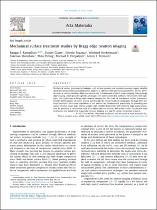JavaScript is disabled for your browser. Some features of this site may not work without it.
- ResearchSpace
- →
- Research Publications/Outputs
- →
- Journal Articles
- →
- View Item
| dc.contributor.author |
Ramadhan, RS

|
|
| dc.contributor.author |
Glaser, Daniel

|
|
| dc.contributor.author |
Soyama, H

|
|
| dc.contributor.author |
Kockelmann, W

|
|
| dc.contributor.author |
Shinohara, T

|
|
| dc.contributor.author |
Pirling, T

|
|
| dc.contributor.author |
Fitzpatrick, ME

|
|
| dc.contributor.author |
Tremsin, AS

|
|
| dc.date.accessioned | 2023-05-12T13:48:00Z | |
| dc.date.available | 2023-05-12T13:48:00Z | |
| dc.date.issued | 2022-10 | |
| dc.identifier.citation | Ramadhan, R., Glaser, D., Soyama, H., Kockelmann, W., Shinohara, T., Pirling, T., Fitzpatrick, M. & Tremsin, A. et al. 2022. Mechanical surface treatment studies by Bragg edge neutron imagin. <i>Acta Materialia, 239.</i> http://hdl.handle.net/10204/12782 | en_ZA |
| dc.identifier.issn | 1359-6454 | |
| dc.identifier.issn | 1873-2453 | |
| dc.identifier.uri | https://doi.org/10.1016/j.actamat.2022.118259 | |
| dc.identifier.uri | http://hdl.handle.net/10204/12782 | |
| dc.description.abstract | Mechanical surface treatment technologies such as laser peening and cavitation peening require detailed characterization, including residual stress analysis, to optimize their processing parameters. Recent developments at neutron facilities allow non-destructive 2-dimensional residual strain mapping through Bragg edge imaging, which provides specific advantages over more established methods. The present work highlights the application of Bragg edge neutron imaging for the study of mechanical surface treatments, through determination of lattice spacing distributions by energy-resolved radiography. Through three different examples, the unique capabilities of the method are demonstrated, particularly for providing near surface residual strain maps within samples with complex geometries with relatively high spatial resolution. By providing a comparison with X-ray diffraction and neutron diffraction results, the present work emphasizes the potential of Bragg edge neutron imaging as a tool for surface treatment research. | en_US |
| dc.format | Fulltext | en_US |
| dc.language.iso | en | en_US |
| dc.relation.uri | https://www.sciencedirect.com/science/article/pii/S1359645422006395 | en_US |
| dc.source | Acta Materialia, 239 | en_US |
| dc.subject | Bragg edge | en_US |
| dc.subject | Cavitation peening | en_US |
| dc.subject | Laser peening | en_US |
| dc.subject | Neutron imaging | en_US |
| dc.subject | Residual stress | en_US |
| dc.subject | Surface treatment | en_US |
| dc.title | Mechanical surface treatment studies by Bragg edge neutron imaging | en_US |
| dc.type | Article | en_US |
| dc.description.pages | 12pp | en_US |
| dc.description.note | ©2022 The Authors. Published by Elsevier Ltd on behalf of Acta Materialia Inc. This is an open access article under the CC BY license (http://creativecommons.org/licenses/by/4.0/). | en_US |
| dc.description.cluster | Manufacturing | en_US |
| dc.description.impactarea | Laser Enabled Manufacturing | en_US |
| dc.identifier.apacitation | Ramadhan, R., Glaser, D., Soyama, H., Kockelmann, W., Shinohara, T., Pirling, T., ... Tremsin, A. (2022). Mechanical surface treatment studies by Bragg edge neutron imaging. <i>Acta Materialia, 239</i>, http://hdl.handle.net/10204/12782 | en_ZA |
| dc.identifier.chicagocitation | Ramadhan, RS, Daniel Glaser, H Soyama, W Kockelmann, T Shinohara, T Pirling, ME Fitzpatrick, and AS Tremsin "Mechanical surface treatment studies by Bragg edge neutron imagin." <i>Acta Materialia, 239</i> (2022) http://hdl.handle.net/10204/12782 | en_ZA |
| dc.identifier.vancouvercitation | Ramadhan R, Glaser D, Soyama H, Kockelmann W, Shinohara T, Pirling T, et al. Mechanical surface treatment studies by Bragg edge neutron imagin. Acta Materialia, 239. 2022; http://hdl.handle.net/10204/12782. | en_ZA |
| dc.identifier.ris | TY - Article AU - Ramadhan, RS AU - Glaser, Daniel AU - Soyama, H AU - Kockelmann, W AU - Shinohara, T AU - Pirling, T AU - Fitzpatrick, ME AU - Tremsin, AS AB - Mechanical surface treatment technologies such as laser peening and cavitation peening require detailed characterization, including residual stress analysis, to optimize their processing parameters. Recent developments at neutron facilities allow non-destructive 2-dimensional residual strain mapping through Bragg edge imaging, which provides specific advantages over more established methods. The present work highlights the application of Bragg edge neutron imaging for the study of mechanical surface treatments, through determination of lattice spacing distributions by energy-resolved radiography. Through three different examples, the unique capabilities of the method are demonstrated, particularly for providing near surface residual strain maps within samples with complex geometries with relatively high spatial resolution. By providing a comparison with X-ray diffraction and neutron diffraction results, the present work emphasizes the potential of Bragg edge neutron imaging as a tool for surface treatment research. DA - 2022-10 DB - ResearchSpace DP - CSIR J1 - Acta Materialia, 239 KW - Bragg edge KW - Cavitation peening KW - Laser peening KW - Neutron imaging KW - Residual stress KW - Surface treatment LK - https://researchspace.csir.co.za PY - 2022 SM - 1359-6454 SM - 1873-2453 T1 - Mechanical surface treatment studies by Bragg edge neutron imagin TI - Mechanical surface treatment studies by Bragg edge neutron imagin UR - http://hdl.handle.net/10204/12782 ER - | en_ZA |
| dc.identifier.worklist | 26696 | en_US |






